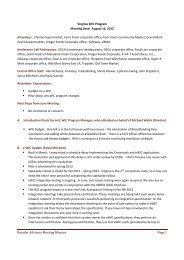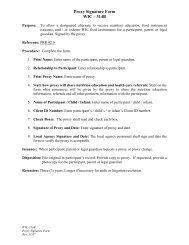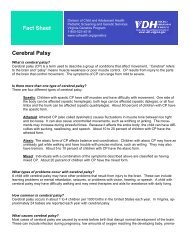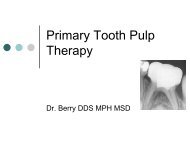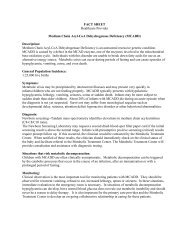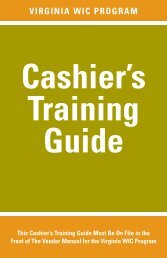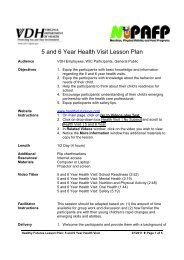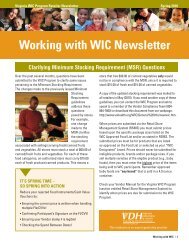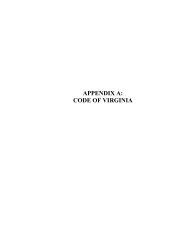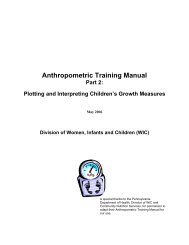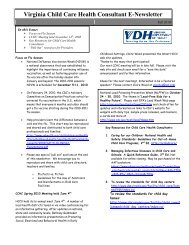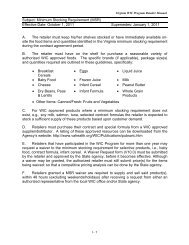WIC EBT Feasibility Study and Cost‐Benefit Analysis
WIC EBT Feasibility Study and Cost‐Benefit Analysis
WIC EBT Feasibility Study and Cost‐Benefit Analysis
You also want an ePaper? Increase the reach of your titles
YUMPU automatically turns print PDFs into web optimized ePapers that Google loves.
Virginia Department of Health <strong>WIC</strong> <strong>EBT</strong> <strong>Feasibility</strong> <strong>Study</strong> <strong>and</strong> Cost-Benefit <strong>Analysis</strong><br />
3. ALTERNATIVES ANALYSIS<br />
3.1 METHODOLOGY<br />
In 2004 FNS released the <strong>WIC</strong> <strong>EBT</strong> National Evaluation Model to be used to prepare a cost<br />
comparison of a State’s paper-based system with an existing e-<strong>WIC</strong> pilot. For this analysis, a<br />
new model was developed to capture baseline data as well as facilitate an analysis of e-<strong>WIC</strong><br />
alternatives. Core elements of the <strong>WIC</strong> <strong>EBT</strong> National Evaluation Model were incorporated into<br />
the <strong>WIC</strong> <strong>EBT</strong> Alternatives <strong>Analysis</strong> Model so that data uncovered during e-<strong>WIC</strong> pilot evaluations<br />
in other States could be used as a comparison against Virginia’s paper-based system. Major<br />
differences between the models include:<br />
• Type of Comparison: The National Evaluation Model was designed to directly compare<br />
a State’s paper-based environment <strong>and</strong> an existing e-<strong>WIC</strong> pilot simultaneously over a<br />
minimum of three months. The Alternatives <strong>Analysis</strong> Model is designed to compare a<br />
State’s paper-based environment <strong>and</strong> up to three assumed alternatives.<br />
• Number <strong>and</strong> Type of Assumptions: As the e-<strong>WIC</strong> environment for a State conducting a<br />
feasibility study has not been completely defined, there are a number of stated<br />
assumptions for the <strong>WIC</strong> <strong>EBT</strong> Alternatives <strong>Analysis</strong> Model that are not required to<br />
complete the National Evaluation Model.<br />
• Time Studies: As other States’ e-<strong>WIC</strong> data (time, materials <strong>and</strong> services) are being used<br />
to create an approximation of the costs for a future e-<strong>WIC</strong> environment, the necessity for<br />
a full three months of State <strong>and</strong> local clinic time studies of the paper-based system was<br />
diminished. Instead, the alternatives analysis is supported by abbreviated time studies of<br />
repetitive actions <strong>and</strong> the State’s estimation of time required for occasional activities.<br />
• Benefits <strong>and</strong> Risks: The Alternatives <strong>Analysis</strong> Model is designed to capture <strong>and</strong> rate the<br />
intangible benefits <strong>and</strong> risks of e-<strong>WIC</strong>, whereas this is not a major component of the<br />
National Evaluation Model.<br />
The following activities were conducted to obtain the data necessary for the alternatives<br />
analysis. 2<br />
3.1.1 ALTERNATIVES COSTS<br />
Cost data <strong>and</strong> information applicable to the various e-<strong>WIC</strong> alternatives were gathered from the<br />
feasibility studies <strong>and</strong> pilot evaluations previously conducted in a range of States <strong>and</strong> through<br />
interviews with VA <strong>WIC</strong> Services staff. Reference reports include:<br />
• Final Evaluation Report from the Michigan <strong>WIC</strong> Program <strong>EBT</strong> Evaluation Project,<br />
September 28, 2007<br />
• <strong>WIC</strong> <strong>EBT</strong> <strong>Feasibility</strong> <strong>Study</strong>/Cost Benefit <strong>Analysis</strong>, Washington State Department of<br />
Health <strong>WIC</strong> Program, September 26, 2007<br />
• Washington State Project Key Outcomes <strong>and</strong> Feedback Report, USDA, FNS, Online<br />
<strong>WIC</strong> <strong>EBT</strong> Demonstration, March 16, 2006<br />
2 To the extent possible, baseline numbers (<strong>WIC</strong> participants, Food Instruments paid, rejected, etc.,) were from the<br />
most recent year of reports available when this assessment began, which was the period from March 2007 through<br />
February 2008. This is referred to as the “analysis year.” Baseline data are provided in Appendix D.<br />
7 V 1.2 August 20, 2008



